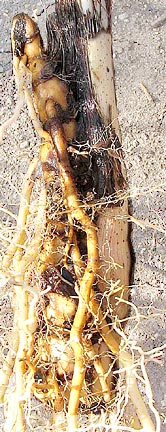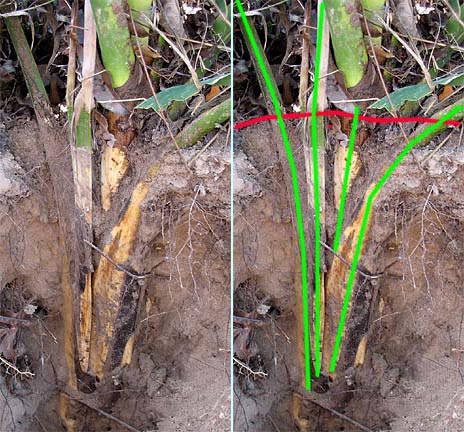I summarize here the main subterranean features of S. minor structure. (I'll refer to palms generally, ignoring the special exceptions.)

S. minor germination |
S. minor with hole showing one edge of underground trunk. |

S. mexicana 'saxiphone' axis |
With all palms (the family Arecaceae) germination is hypogeal (takes place underground). All subsequent growth originates from a single point, the apical meristem (also known as the (terminal) bud or heart). With Sabal palms in general, early establishment growth also remains underground, with new leaves emerging vertically above ground from a meristem that moves ever obliquely downward (positively geotropic growth). Each leaf grows erect requiring a reorientation of almost 180 degrees upward from the descending meristem, thus creating what palm authority P. B. Tomlinson calls a 'saxophone axis.' Establishment growth is followed by upward growth for many Sabal palms, creating a trunk.
Sabal germination
Sabal 'saxophone' axis
Sabal establishment growth
| Spear leaf |
But with S. minor this growth bud remains at the subterranean base of the plant – and consequently the 'trunk' is not apparent. The youngest, unopened leaf, the spear leaf, arises from the apical meristem in the center of this underground trunk, surrounded by layers of previous leaf petioles (leafstalks), which serve to protect it. In the picture on the right the petioles of earlier leaves can be seen arising from some distance below ground level. |

Underground petioles |
Palms are unlike many other familar plants, even other monocotyledons, which have multiple growth buds. With these, damage to the apical meristem may lead to other primary growth being shifted to a secondary bud. With the soaptree yucca (Yucca elata), also a monocot, fire damage to the apical meristem may result in regrowth from an unburned portion of the stem. Damage to a palm's growth bud will cause growth to cease, and the eventual (although perhaps not rapid) death of the palm.
On the other hand, damage to a palms roots or leaves, even those of a Sabal, is not necessarily fatal. Cf. Pittenger et al., "Palm Root Regeneration and Its Significance in Transplanting":
There has been limited study on the distribution and growth of palm roots in relation to the survival and reestablishment of large, transplanted, field-grown trees. Research on field-grown trees in Florida found that the branching response of cut roots varies among palm species. In Sabal palmetto nearly all of the roots cut during transplanting died completely, and this species essentially generated a new root system from the base of the trunk to survive.
S. minor is known as one of the cold hardiest palms, no doubt because the meristem is well protected underground. Similarly, other Sabal species (e.g., S. palmetto)are known to survive wildfires while in the juvenal establishment phase.